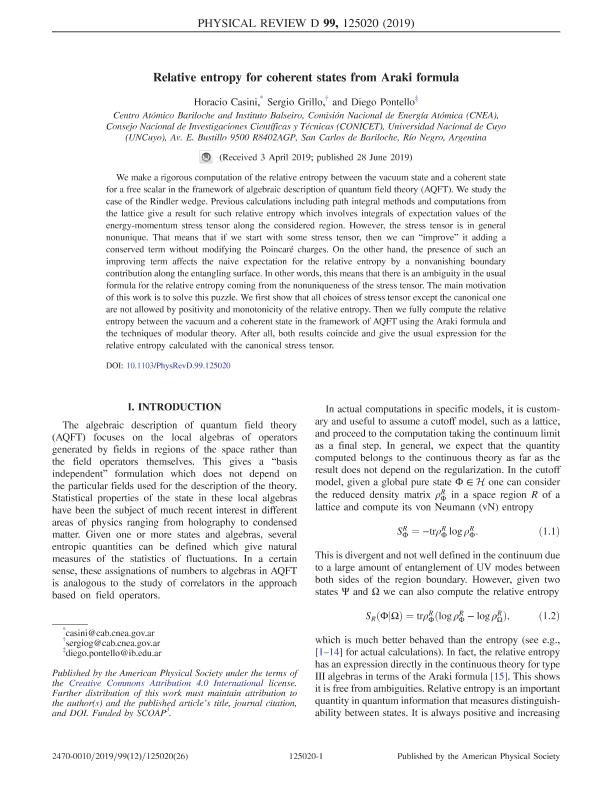Mostrar el registro sencillo del ítem
dc.contributor.author
Casini, Horacio German

dc.contributor.author
Grillo, Sergio Daniel

dc.contributor.author
Pontello, Diego Esteban

dc.date.available
2021-02-10T01:49:17Z
dc.date.issued
2019-06-28
dc.identifier.citation
Casini, Horacio German; Grillo, Sergio Daniel; Pontello, Diego Esteban; Relative entropy for coherent states from Araki formula; American Physical Society; Physical Review D; 99; 125020; 28-6-2019; 1-26
dc.identifier.issn
2470-0010
dc.identifier.uri
http://hdl.handle.net/11336/125236
dc.description.abstract
We make a rigorous computation of the relative entropy between the vacuum state and a coherent state for a free scalar in the framework of algebraic description of quantum field theory (AQFT). We study the case of the Rindler wedge. Previous calculations including path integral methods and computations from the lattice give a result for such relative entropy which involves integrals of expectation values of the energy-momentum stress tensor along the considered region. However, the stress tensor is in general nonunique. That means that if we start with some stress tensor, then we can "improve" it adding a conserved term without modifying the Poincaré charges. On the other hand, the presence of such an improving term affects the naive expectation for the relative entropy by a nonvanishing boundary contribution along the entangling surface. In other words, this means that there is an ambiguity in the usual formula for the relative entropy coming from the nonuniqueness of the stress tensor. The main motivation of this work is to solve this puzzle. We first show that all choices of stress tensor except the canonical one are not allowed by positivity and monotonicity of the relative entropy. Then we fully compute the relative entropy between the vacuum and a coherent state in the framework of AQFT using the Araki formula and the techniques of modular theory. After all, both results coincide and give the usual expression for the relative entropy calculated with the canonical stress tensor.
dc.format
application/pdf
dc.language.iso
eng
dc.publisher
American Physical Society

dc.rights
info:eu-repo/semantics/openAccess
dc.rights.uri
https://creativecommons.org/licenses/by/2.5/ar/
dc.subject
Relative entropy
dc.subject
Modular Theory
dc.subject
Coherent states
dc.subject.classification
Física de Partículas y Campos

dc.subject.classification
Ciencias Físicas

dc.subject.classification
CIENCIAS NATURALES Y EXACTAS

dc.title
Relative entropy for coherent states from Araki formula
dc.type
info:eu-repo/semantics/article
dc.type
info:ar-repo/semantics/artículo
dc.type
info:eu-repo/semantics/publishedVersion
dc.date.updated
2020-12-16T18:19:34Z
dc.identifier.eissn
2470-0029
dc.journal.volume
99
dc.journal.number
125020
dc.journal.pagination
1-26
dc.journal.pais
Estados Unidos

dc.description.fil
Fil: Casini, Horacio German. Comisión Nacional de Energía Atómica. Gerencia del Área de Energía Nuclear. Instituto Balseiro. Archivo Histórico del Centro Atómico Bariloche e Instituto Balseiro | Universidad Nacional de Cuyo. Instituto Balseiro. Archivo Histórico del Centro Atómico Bariloche e Instituto Balseiro; Argentina. Comisión Nacional de Energía Atómica. Centro Atómico Bariloche; Argentina. Consejo Nacional de Investigaciones Científicas y Técnicas. Centro Científico Tecnológico Conicet - Patagonia Norte; Argentina
dc.description.fil
Fil: Grillo, Sergio Daniel. Comisión Nacional de Energía Atómica. Gerencia del Área de Energía Nuclear. Instituto Balseiro. Archivo Histórico del Centro Atómico Bariloche e Instituto Balseiro | Universidad Nacional de Cuyo. Instituto Balseiro. Archivo Histórico del Centro Atómico Bariloche e Instituto Balseiro; Argentina. Comisión Nacional de Energía Atómica. Centro Atómico Bariloche; Argentina. Consejo Nacional de Investigaciones Científicas y Técnicas. Centro Científico Tecnológico Conicet - Patagonia Norte; Argentina
dc.description.fil
Fil: Pontello, Diego Esteban. Comisión Nacional de Energía Atómica. Gerencia del Área de Energía Nuclear. Instituto Balseiro. Archivo Histórico del Centro Atómico Bariloche e Instituto Balseiro | Universidad Nacional de Cuyo. Instituto Balseiro. Archivo Histórico del Centro Atómico Bariloche e Instituto Balseiro; Argentina. Comisión Nacional de Energía Atómica. Centro Atómico Bariloche; Argentina. Consejo Nacional de Investigaciones Científicas y Técnicas. Centro Científico Tecnológico Conicet - Patagonia Norte; Argentina
dc.journal.title
Physical Review D
dc.relation.alternativeid
info:eu-repo/semantics/altIdentifier/url/https://journals.aps.org/prd/abstract/10.1103/PhysRevD.99.125020
dc.relation.alternativeid
info:eu-repo/semantics/altIdentifier/doi/https://doi.org/10.1103/PhysRevD.99.125020
dc.relation.alternativeid
info:eu-repo/semantics/altIdentifier/url/https://arxiv.org/abs/1903.00109
Archivos asociados
